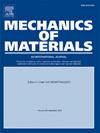通过预压缩抵抗钛合金的室温蠕变
IF 3.4
3区 材料科学
Q2 MATERIALS SCIENCE, MULTIDISCIPLINARY
引用次数: 0
摘要
对于深海潜水器,钛合金在轻质耐压壳体中的使用寿命取决于室温蠕变变形。在深海高应力条件下,软晶粒的位错滑移是室温蠕变的主要机制。根据位错堆积和背应力硬化的原理,对Ti80合金进行了预压缩处理。预压缩后,某些较软晶粒的位错密度增加了1.9 ~ 2.5倍,而平均位错密度仅增加了22%。这种处理有效地提高了临界分解剪应力(CRSS),增强了对位错运动的抵抗力。因此,在90%屈服强度下蠕变1000 h后,蠕变应力阈值至少提高14%,总蠕变应变降低80%。为了准确描述Ti80合金的蠕变行为,建立了基于背应力演化的蠕变本构模型。该模型包含预压缩处理引起的初始背应力的估计及其对位错滑移的影响。研究结果为深海耐压船体材料的优化及其长期性能预测提供了重要见解。本文章由计算机程序翻译,如有差异,请以英文原文为准。
Resisting room-temperature creep in titanium alloys by pre-compression
For deep-sea submersibles, the service life of titanium alloys in lightweight pressure hulls is dictated by room-temperature creep deformation. Under high stress in deep-sea, the mechanism for room-temperature creep is primarily dominated by dislocation slip in the soft grains. Guided by the principles of dislocation pile-up and back stress hardening, a pre-compression treatment was applied to Ti80 alloy. Via pre-compression, the dislocation density increased significantly by 1.9–2.5 times in some softer grains whereas the average dislocation density only experienced a 22 % increase. This treatment effectively elevated the critical resolved shear stress (CRSS) and enhanced the resistance to dislocation motion. Accordingly, the creep stress threshold is raised by at least 14 % and the total creep strain is reduced by 80 % after 1000 h of creep at 90 % the yield strength. A creep constitutive model based on back stress evolution was developed to accurately describe the creep behavior of Ti80 alloy. That model incorporates an estimation of the initial back stress induced by pre-compression treatment and its effect on dislocation slip. The results demonstrate crucial insights into the optimization of materials for deep-sea pressure hulls and their long-term performance prediction.
求助全文
通过发布文献求助,成功后即可免费获取论文全文。
去求助
来源期刊

Mechanics of Materials
工程技术-材料科学:综合
CiteScore
7.60
自引率
5.10%
发文量
243
审稿时长
46 days
期刊介绍:
Mechanics of Materials is a forum for original scientific research on the flow, fracture, and general constitutive behavior of geophysical, geotechnical and technological materials, with balanced coverage of advanced technological and natural materials, with balanced coverage of theoretical, experimental, and field investigations. Of special concern are macroscopic predictions based on microscopic models, identification of microscopic structures from limited overall macroscopic data, experimental and field results that lead to fundamental understanding of the behavior of materials, and coordinated experimental and analytical investigations that culminate in theories with predictive quality.
 求助内容:
求助内容: 应助结果提醒方式:
应助结果提醒方式:


